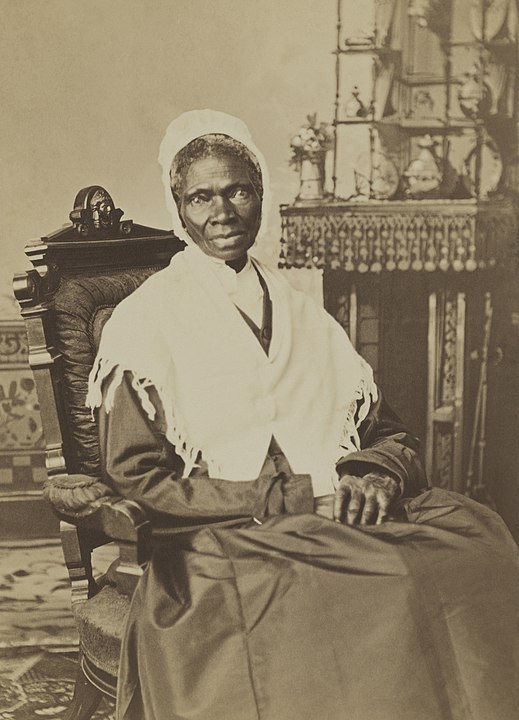Sojourner Truth
(1797-1883)
Sojourner Truth was a nationally renowned activist for abolition, women's rights, and racial equality in the 19th century. She was born "Isabella Baumfree," a slave in Dutch-speaking Ulster County, New York in 1797. She was bought and sold four times and eventually bore five children with another slave named Thomas. During this time she was subject to grating physical labor and violent punishments. In 1827—one year before New York's bill to free slaves took effect—Baumfree ran away to the Van Wagener's household, a nearby abolitionist family. They bought her and her infant daughter's freedom. Baumfree also fought fearlessly for the successful return of her five-year-old son, Peter, who had been sold illegally in Alabama.
Around 1829, Baumfree moved to New York City where she made a living through domestic employment and spent some time getting involved with the religious revivals sweeping the state at the time. After receiving revelation to preach the truth, she changed her name to Sojourner Truth and eventually moved to Northampton, Massachusetts. While there, she met some of the country's most prominent abolitionists, William Lloyd Garrison and Frederick Douglass, and became active in the antislavery movement. At this point, she was widely known for her lecturing tours where she would debate, sing, and speak publicly for various reform causes. That year, she dictated her enlightening autobiography, The Narrative of Sojourner Truth, the proceedings of which helped her pay her mortgage.


In the early 1850s, Truth met women's rights activists Elizabeth Cady Stanton and Susan B. Anthony, and swiftly championed the cause for women's suffrage too. Truth performed public speeches, brought cases to court successfully, performed sit-ins, and petitioned Congress as part of her fight. In 1851, she began a lecture tour where she performed her famous speech, "Ain't I a Woman?" in Akron, Ohio.
Truth settled in Battle Creek, Michigan with her three daughters. When the American Civil War commenced, she gathered supplies for black troops and, after the war, was honored with an invitation to the White House by President Abraham Lincoln. In 1864, she went to Washington, D.C. to help integrate streetcars. She also became involved with the Freedmen's Bureau, helping freed slaves find employment and build new lives. Toward the end of her life, Truth was almost blind and deaf, and spent her last years in Michigan, passing away on November 26th, 1883 from old age. Today, Sojourner Truth can be found in paintings, statues, and history textbooks. The US Treasury recently announced that she will be featured on the new ten dollar bill to commemorate the 100th anniversary of the 19th amendment.
"Truth is powerful, and it prevails."
"We do as much, we eat as much, we want as much."
-Sojourner Truth
Learn More
Read Sojourner Truth's The Narrative of Sojourner Truth online through the McKay Library. Additionally, read or watch an interpretation of Truth’s speech, "Ain't I a Woman?"
Works Cited
Britannica Academic, s.v. "Sojourner Truth," accessed October 27, 2020, https://academic-eb-com.byui.idm.oclc.org/levels/collegiate/article/Sojourner-Truth/73571.
"Truth, Sojourner." In Notable American Women, 1607-1950, Volume III: P-Z, edited by Edward T. James, Janet Wilson James, and Paul Samuel Boyer, 482-83. Cambridge, MA: Harvard University Press, 1971. https://search.alexanderstreet.com/view/work/bibliographic_entity%7Cdocument%7C2515944.
National Women’s History Museum, “Sojourner Truth,” https://www.google.com/culturalinstitute/exhibit/vwIi3HBUyJcCIA?hl=en
